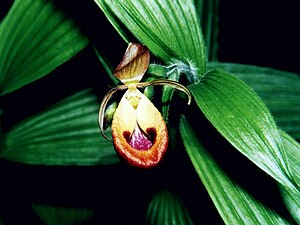Selenipede
| Selenipede | ||||||||||||
|---|---|---|---|---|---|---|---|---|---|---|---|---|

|
||||||||||||
| Systematics | ||||||||||||
|
||||||||||||
| Scientific name | ||||||||||||
| Selenipede | ||||||||||||
| Rchb. f. |
The lady's slipper genus Selenipedium belongs to the orchid family (Orchidaceae). The approximately nine species are distributed from Central America to the northern part of South America.
description
Vegetative characteristics
They are terrestrial, perennial herbaceous plants . The roots are fibrous, the Velamen radicum consists of only one layer of cells, and there is no root hair. The upright or arching overhanging stems arise from a short, fleshy, starch-storing rhizome . The 2 to 5 meter long stems lean against the surrounding plants , like splayers . They are simple or branched, somewhat lignified at the bottom.
The leaves are thin in texture, broad to narrowly lanceolate in shape, tapering to a point, crinkled along the numerous leaf veins (plicative bud position ). The leaf goes into a leaf sheath encompassing the stem, there is no separating tissue from the leaf base. The leaves are smooth or hairy, often ciliate at the edge.
Generative characteristics
The terminal, racemose or slightly branched inflorescence is hairy. The bracts are hairy. The hairy peduncle is short. The hairy inflorescence axis loosely contains numerous flowers . The resupinated flowers open quickly one after the other.
The hermaphrodite flowers are zygomorphic and threefold. The short-stalked, hairy ovary is cylindrical, quite slender, three-chambered with axial placentation . Sepals and petals are splayed. The outside of the sepals are hairy. The dorsal sepal stands upright, it is more or less concave in shape. The lateral sepals have grown together to form a synsepal, this is shaped similarly to the dorsal sepal, but smaller, quite deeply concave, with two teeth at the tip. The sepals lie valvat in the bud . The free petals are more or less linear-elongated. The lip is shoe-shaped, inflated, with a wedge-shaped base, the edge around the opening is turned inwards. The lip is larger than the synsepal. The column is rather short and cylindrical. The column carries two fertile stamens and one sterile one ( staminodium ). The two stamens are to the side of the stigma , they are short-stalked, rounded, two-chambered and contain the powdery or sticky pollen . The staminodium is at the end of the column, it is usually longer than the scar, the shape depends on the species. The stalk has a very short stalk, pointing downwards, triangular in shape.
The cylindrical to spindle-shaped capsule fruit is provided with three longitudinal ribs. The bracts stay on for a long time. The fruits give off a vanilla scent. The round seeds have a hard seed coat.
Locations
Most of the species thrive in the lowlands , only Selenipedium steyermarkii was found at altitudes of 1800 meters.
Systematics, botanical history and distribution
Selenipedium was first described in 1854 by Heinrich Gustav Reichenbach in the magazines Bonplandia and Xenia orchidacea . The generic name Selenipedium is made up of selene for "moon" or "crescent", as well as pedilon , "shoe". It refers to the semi-circular curved edges of the lip.
Within the subfamily Cypripedioideae , Selenipedium represents the basal group:
|
|||||||||||||||||||||||||
|
|
The distribution area extends is neotropical . It stretches from Panama via Venezuela and Colombia to Ecuador, with Trinidad, the Guiana and the northeast of Brazil being settled in the northeast. The spread is poorly documented.
The nine or so Selenipedium species are:
- Selenipedium aequinoctiale Garay : It occurs in Ecuador .
- Selenipedium buenaventurae (Szlach. & Kolan.) PJCribb : It occurs only in northwestern Colombia .
- Selenipedium chica Rchb. f. & Warsz. : This endemic occurs only in western Panama .
- Selenipedium dodsonii P.J.Cribb : The species first described in 2015 occurs only in northern Ecuador.
- Selenipedium isabelianum Barb. Rodr. : It occurs in the Brazilian states of Pará and Bahia .
- Selenipedium olgae Szlach. & Kolan. : It was first described in 2016 from Colombia.
- Selenipedium palmifolium (Lindl.) Rchb. f. & Warsz. : It occurs from the island of Trinidad to northern Brazil.
- Selenipedium steyermarkii Foldats : It occurs from southeastern Venezuela to Guyana and in the Brazilian state of Roraima .
- Selenipedium vanillocarpum Barb . Rodr . : It occurs in the Brazilian state of Goiás .
See also
supporting documents
Most of the information in this article comes from:
- Leslie A. Garay: 225 (1). Orchidaceae (Cypripedioideae, Orchidoideae and Neottioideae) . In: Gunnar Harling, Benkt Sparre (ed.): Flora of Ecuador . tape 9 , 1978, ISSN 0347-8742 , p. 12-13 .
- Alec M. Pridgeon, Phillip J. Cribb, Mark W. Chase, Finn N. Rasmussen (Eds.): Genera Orchidacearum. General Introduction, Apostasioideae, Cypripedioideae . tape 1 . Oxford University Press, New York and Oxford 1999, ISBN 0-19-850513-2 , pp. 132-137 .
Individual evidence
- ↑ a b c d e f g h i j k l Rafaël Govaerts (Ed.): Selenipedium. In: World Checklist of Selected Plant Families (WCSP) - The Board of Trustees of the Royal Botanic Gardens, Kew . Retrieved July 20, 2018.
- ^ HG Reichenbach: Xenia orchidacea: Contributions to the knowledge of the orchids. Volume 1, FA Brockhaus, Leipzig 1854, p. 3. Scan from botanicus.org



